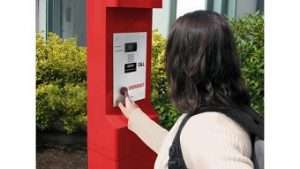
Intercoms are generally the first line of communications, entry control and emergency assistance, and they are used in virtually every vertical market. Anyone who attended a high school probably started each day with announcements over the intercom. Remember hearing about the daily cafeteria specials and reminders to turn in forms? Those early-morning classroom announcements have not changed much through the years, but the intercom technology certainly has. Instead of simple public address, the technology is now being integrated with other systems to control doors and gates, create alarms, provide valuable video and create more efficient security operation centers.
For example, nearly 100 percent of hospitals use intercoms for nurse-call stations and to protect entry doors, parking garages, pharmacies and nurseries. More than 80 percent of public and private K-12 and higher education campuses use at least one intercom – including blue-light outdoor emergency stations. Many cities now require the use of audio and video intercoms on multi-family buildings that are more a certain number of units; and about 40 percent of commercial facilities use them. They also protect every U.S. military recruitment center and many well-known Washington, D.C., government facilities.
Like the video surveillance market, the intercom market is gradually shifting to IP-based units, although there are still many analog systems – with their simple two-wire installation – being installed and used. Intercom manufacturers can harness digital networks to provide more features and benefits for integrators and end-users. This ensures that intercoms are no longer an add-on product, and users are not limited to talking with staff on the opposite side of a campus – they can communicate with buildings across a city or even the country.
IP-based intercoms typically use new or existing Cat-5e or Cat-6 wiring. Rather than automatically replacing older wiring, many integrators re-use existing cable that is almost always still serviceable. In fact, dropping the cost of running new cable on estimates is a cost-saving strategy employed by many integrators to help them win new jobs and projects. Ethernet converters from a variety of sources enable the integrator get IP performance over the existing coax cable.
IP-based system programming for intercoms is becoming simpler; in fact, some intercoms enable integrators and building management to remotely update tenant directories using a local network. Updating tenant names and dialing numbers can also be completed onsite using an NFC-equipped smartphone or tablet. This represents an RMR opportunity for integrators, who can easily offer remote updating services to their customers.
The IP technology provides backward-compatible systems, and open standards enable scalability to future-proof today’s investments. Some units offer self-diagnosing software capable of monitoring performance and creating alerts when something goes wrong. By monitoring the alerts and responding, dealers and integrators can again create an additional revenue source.
Today’s intercoms can integrate with other open standard platforms, providing greater overall system control and more efficient security operation centers. Intercom-specific mobile apps also make it easier for roaming guards to answer intercom calls while on patrol.
An example of a successful integration can be seen at a school where an integrator installed panic buttons. Pushing a button generates a pre-recorded message – containing a code phrase to generate an immediate lockdown without frightening the students – shared throughout the facility via the intercom’s horns and speakers.
Video intercoms are a natural fit with a VMS. By sending all intercom-generated video directly to a VMS, end-users can monitor area surrounding an entry and keep track of visitors. Intercom door stations can also include embedded card readers for a 3-in-1 entry solution. In addition to usable video footage, many organizations require intelligible voice communication – whether routine announcements or emergency instructions. Coupled with amplified speakers, intercoms can provide clear speech even in high-noise environments like warehouses, manufacturing facilities or even mining operations.
While two-way audio has been available for decades, end-users are now asking for two-way video. Also, expect intercoms to serve as a tool for outbound and internal communications. For example, units will routinely “talk” with mobile phones, and when master station calls go unanswered, door stations will make calls to guards or other selected employees to assist visitors. Because of the ease of installation, intercoms are also attracting the attention of locksmiths again. A locksmith recently said that integrators do not view him as competition, but instead as a partner helping with projects that include up to 10 doors. It seems like a natural fit for someone already on the job installing electric strikes or mag locks on doors to simply add an easy-to-install intercom to the project.











